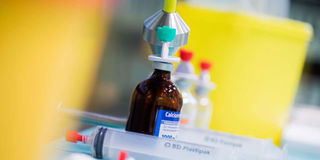When liberal market does not mean cheaper drugs

Cancer drugs in a laboratory. Lack of standardisation has been blamed for the difference in the cost of drugs. FOTOSEARCH | NATION MEDIA GROUP
Kenyans are paying dearly for the lack of transparency on drug prices in the country.
Compared to other countries, Kenyans have to pay huge amounts of money for life-saving drugs.
For instance, a comparison between the prices in Kenya and other countries, from where most of the drugs are imported, revealed that Kenyans are paying double or even thrice the amount.
After a kidney transplant, a patient requires a cocktail of drugs to keep the organ active to avoid rejection. However, in order for a kidney survivor to stay alive, he must use at least Sh42,000 per month for the drugs while a patient in India who is using the same drug will pay Sh30,000 less over a similar period.
LEVY MARKUP
A tablet of Augmentin, a common antibiotic for treating pneumonia, goes for Sh950 in Kenya while in the UK it is sold at Sh150.
Sandostatin Lar (20mg), a cancer drug manufactured by a Swiss pharmaceuticals company, costs Sh60,000 in India, but in Kenya, the same medicine goes for more than Sh210,000. The drug costs less in other European countries.
High blood pressure drugs are sold in a public hospital for at least Sh2,000 while a patient would buy the same drugs at Sh335 in Italy and Turkey, according to the figures seen by the HealthyNation.
This means Kenyans are paying heavily for drugs while those who cannot afford them die in silence.
But, why are drug prices so much higher in Kenya than other European countries with the same per capita income?
Lack of standardisation has been blamed for the difference in costs with wholesalers levying markups as high as they wish. Wholesale margins may range around an average of 14 per cent of which eight per cent is for overheads and six per cent is profit. “This varies by medicine. For instance, a common generic antibiotic may have a margin of three per cent, but a brand name statin may be up to 23 per cent,” according to the report.
According to Dr Fred Siyoi, chief executive officer, Pharmacy and Poisons Board (PPB), there are no strategies to lower drug prices including control and regulation of prices in the country.
This, he said, is also affected by the liberalised market of willing buyer and a willing seller. The government does not impose any tariffs on finished pharmaceutical products, whether locally manufactured or imported.
PRICE DISCLOSURE
Dr Siyoi said manufacturers and importers of medicine do not disclose prices to PPB at the time of applying for marketing authorisation. The disclosure of prices, he said, is a critical step in promoting transparency in the pricing of medicine. “Currently, when one is need of a drug, they will buy it regardless of the price because they badly need it,” said Dr Siyoi.
He also told HealthyNation there was no system in place for price setting of drugs in the country.
The Ministry of Health recommends that essential medicine commodities be declared under essential commodities Act to ensure that people are not exploited.
“The Price Control (Essential Goods) Act empowers the Treasury minister to declare and gazette any goods to be essential commodities, and to determine the maximum price in consultation with the industry,” he said.
The board has come up with strategies on how to reduce and even publish drug prices. The document is with the ministries of Health, Trade and Treasury awaiting approval. “The strategy will dictate how the prices can be reduced and give a maximum price for all medicine,” he said.
WEALTHIER COUNTRIES
According to a research brief on the pharmaceutical pricing regulations in Kenya drafted by the think-tank Africa Centre for Technology Studies, the liberalised market has not translated to lower prices, thereby, locking out many Kenyans. According to a report by the World Health Organisation released last week, the cost of production of most medicine was a small fraction of the final price paid by governments, patients or insurance schemes.
The report blamed a lack of transparency around prices paid by governments, meaning that many low- and middle-income countries paid higher prices for certain medicine than wealthier countries.
This, in turn, made the cost of healthcare very expensive.
Costly health bills are set to worsen the prospects of hapless, cash-strapped Kenyans in a country with at least 17.4 million people living below Sh92.4 per day, according to 2018 World Bank data on poverty rates.
“This is a global human rights issue. Everyone has a right to access quality healthcare”, said WHO Assistant Director-General for Medicines and Health Products Mariângela Simão.
WHO is set to launch an online public consultation in the coming weeks to collect views and suggestions for a definition of what constitutes a ‘fair price’.



